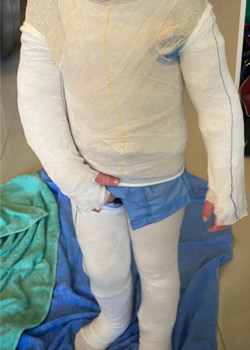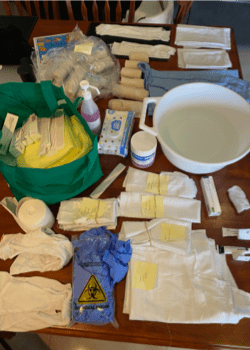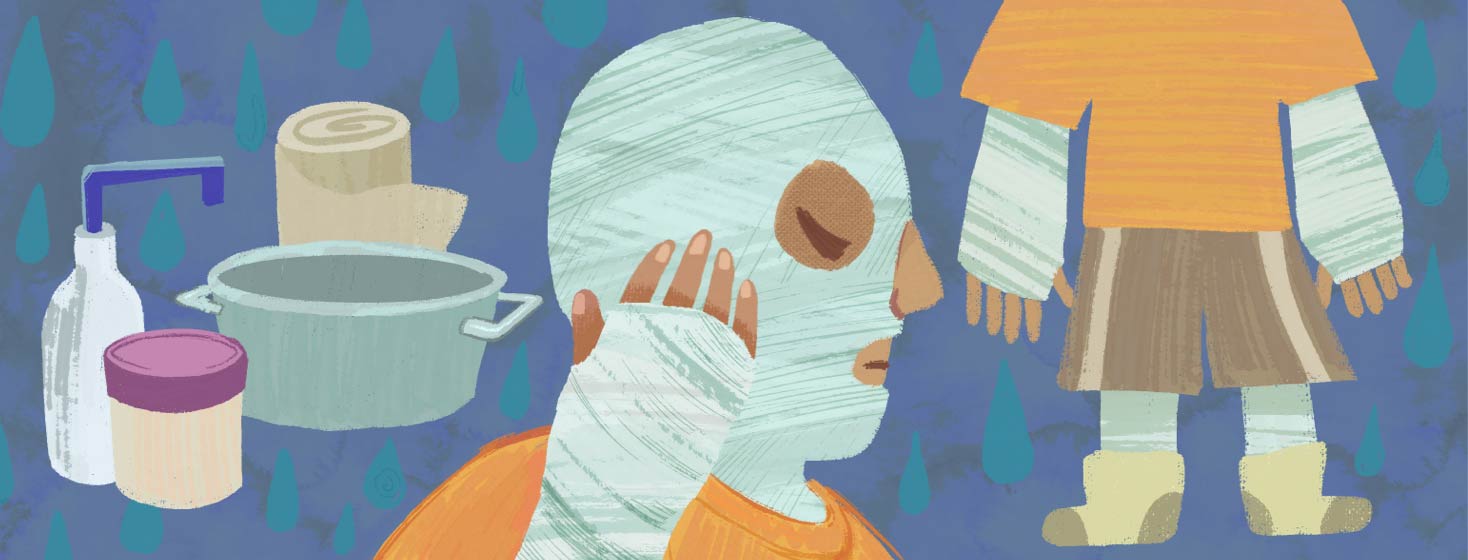My Son's 5-Day Wet Dressing Treatment
Wet dressings are a great way to help with severe eczema. They cover and protect the skin from the damage caused by a child’s scratching. The application of cool linen can provide relief from the heat and itching sensation of eczema as the water from the linen evaporates. The wet dressings also help to hydrate the skin and enhance the absorption of moisturizers and topical corticosteroids.1
Have I done this with my son?
Wet dressings can be hard, but if prepared both mentally and with the equipment, it can go smoothly. Little Harry did this 5-day wet dressing, and there was an improvement. This was pretty traumatic for him, but he did amazing standing still for the application and not taking it off.

This 5-day wet dressing treatment is done 3 times a day - in the morning, mid-day, and before bed. Yes, it needs to be worn to bed too.
Before starting, consult your health provider. This was done for Harry through a program at a skin clinic in a children’s hospital.
How do you prepare?
- Step 1 - Prepare Yourself Make sure you are mentally prepared for this treatment. It is a lot of work, both physically and mentally.
- Step 2 - Gather Materials Cut out pieces of 100% cotton material (can use an old sheet) to the length of limbs, feet, hands, torso, and face (if needed). Also, cut Tubifast Bandages to the size of limbs, torso, and head. For the head one, cut out the eyes and the mouth and nose hole.
- Step 3 – Set up Your Station

What should be at your setup station?
Make a setup station for the 5 days. I used it on the end of my kitchen table. The equipment needed:
- Bucket with warm water
- 2 tubs of 500g Dermeze ointment
- Wooden medical spatula’s (to stop cross contamination when scooping ointment)
- Corticosteroid creams
- Pre-cut 100% cotton material
- 6 crepe bandages (4 for each limb, 2 for the torso)
- Tubifast bandages
- Towel - to stand on
How do you apply the wet dressing?
- Step 1 - Apply a generous amount of steroid cream anywhere there is red on the skin.
- Step 2 - Using the wooden medical spatula, scoop out a large amount of ointment and lather all over the body.
- Step 3 - Place the 100% cotton material in the bucket of warm water to drench it. Squeeze it enough to stop it from dripping and wrap it around the foot, ankle, and leg all in one wrap. Make sure it is wrapped smoothly with no creases so it is still easy to move around.
- Step 4 - Wrap the limb with the wet material with a bandage – to hold the material in place.
- Step 5 - Put the Tubifast bandage over the top of the crepe bandage.
- Step 6 - Repeat these steps for each limb and torso. For the torso, wrap it around the shoulders and belly like a closed vest.
- Step 7 - For the head, only the wet material is on his face. Ensure the holes around the eyes and the mouth and nose hole are big enough to breathe and see. Do not wear this to bed. The Tubifast bandage goes on like a beanie.
- Step 8 - Wear normal loose clothing over the top.
- Step 9 - Wash all linen and bandages after each wet dressing. I had 3 prepared. One in use, one in the wash, and the other ready for the next use.
This is everything that is worn for wet dressings.

What else would I recommend?
I found this extremely exhausting, both physically and mentally. When doing the "5-Day Wet Dressing Treatment," make sure you are prepared for an intense week. Since the wet dressing needs to be done 24/7 for 5 days, it’d be best if you cleared your schedule and don’t leave the house.
Note: Since there are lots of layers on (bandages, Tubifast, wet material, clothes), it is harder to move around.
P.S. You don’t have to use corticosteroid ointment if you don’t want to. This was done as a requirement through the clinic to go to the next step for further treatment.

Join the conversation